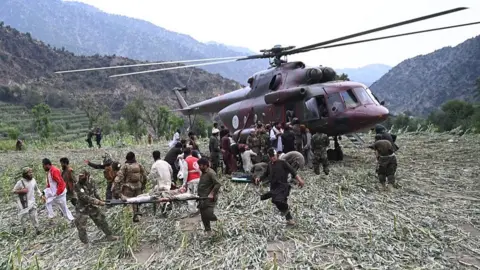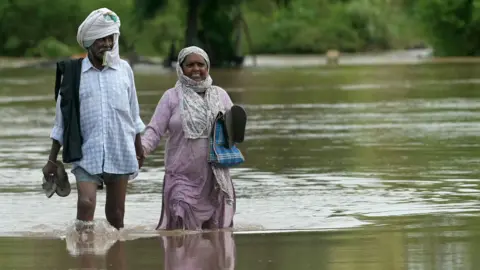The article text:
In the wake of a significant earthquake occurring off the coast of Russia, a tsunami warning has led many Hawaiians to evacuate coastal regions, following official advice aimed at safeguarding lives and property. As of Tuesday evening, several feet-high waves were being reported across the islands of Maui, Oahu, and Hawaii, including its capital, Honolulu, according to the Pacific Tsunami Warning Center. The center urged individuals to take immediate action, noting that the danger posed by the tsunami could continue for several hours.
Hawaii's Governor, Josh Green, encouraged residents in low-lying areas to remain calm and relocate to higher ground while also suggesting that, as of yet, no significant "wave of consequence" had been observed. However, reports indicated that highways were increasingly congested as people evacuated their homes. Maui residents, still reeling from the impacts of devastating wildfires two years ago, were particularly urged to seek safer elevations.
Meanwhile, the US west coast - including states like California and Alaska - also braced for the potential impact, operating under a lesser tsunami advisory from the National Tsunami Warning Center. While a warning indicates imminent flooding, an advisory signifies that dangerous currents could develop. Dr. Lucy Jones, a seismologist, speculated that while the waves could cause damage to coastal properties in both Hawaii and California, the potential for mass casualties was minimal compared to historical disasters like the deadly tsunami in Japan in 2011, where waves reached 42ft (13m).
Despite the relatively lower expectation for danger, many residents in Hawaii were not taking any risks. David Dorn, a longtime resident of Kihei on Maui, described his approach as cautious. After 30 years living by the ocean, he and his wife took the recent warning seriously, opting to relocate to higher ground for safety. Mr. Dorn expressed concern about traffic congestion during the emergency, which he noted was worsening as the evacuation unfolded.
With roads resembling “like New York City right now,” as another Maui resident noted, many people shifted their priorities, abandoning plans to stock up on groceries in favor of safety. Felicia Johnson, a lifelong islander, shared similar sentiments, recalling the harrowing experience of the Lahaina fires two years ago and expressing fear as the ocean levels began to change. “It’s eerily weird,” she remarked, as she prepared to spend the night with family in the mountains, reflecting on the importance of heeding warnings.
Shelters have been opened, and local authorities have shut down water facilities in preparation for potential damage, emphasizing the state’s ongoing vigilance in the face of natural threats.
In the wake of a significant earthquake occurring off the coast of Russia, a tsunami warning has led many Hawaiians to evacuate coastal regions, following official advice aimed at safeguarding lives and property. As of Tuesday evening, several feet-high waves were being reported across the islands of Maui, Oahu, and Hawaii, including its capital, Honolulu, according to the Pacific Tsunami Warning Center. The center urged individuals to take immediate action, noting that the danger posed by the tsunami could continue for several hours.
Hawaii's Governor, Josh Green, encouraged residents in low-lying areas to remain calm and relocate to higher ground while also suggesting that, as of yet, no significant "wave of consequence" had been observed. However, reports indicated that highways were increasingly congested as people evacuated their homes. Maui residents, still reeling from the impacts of devastating wildfires two years ago, were particularly urged to seek safer elevations.
Meanwhile, the US west coast - including states like California and Alaska - also braced for the potential impact, operating under a lesser tsunami advisory from the National Tsunami Warning Center. While a warning indicates imminent flooding, an advisory signifies that dangerous currents could develop. Dr. Lucy Jones, a seismologist, speculated that while the waves could cause damage to coastal properties in both Hawaii and California, the potential for mass casualties was minimal compared to historical disasters like the deadly tsunami in Japan in 2011, where waves reached 42ft (13m).
Despite the relatively lower expectation for danger, many residents in Hawaii were not taking any risks. David Dorn, a longtime resident of Kihei on Maui, described his approach as cautious. After 30 years living by the ocean, he and his wife took the recent warning seriously, opting to relocate to higher ground for safety. Mr. Dorn expressed concern about traffic congestion during the emergency, which he noted was worsening as the evacuation unfolded.
With roads resembling “like New York City right now,” as another Maui resident noted, many people shifted their priorities, abandoning plans to stock up on groceries in favor of safety. Felicia Johnson, a lifelong islander, shared similar sentiments, recalling the harrowing experience of the Lahaina fires two years ago and expressing fear as the ocean levels began to change. “It’s eerily weird,” she remarked, as she prepared to spend the night with family in the mountains, reflecting on the importance of heeding warnings.
Shelters have been opened, and local authorities have shut down water facilities in preparation for potential damage, emphasizing the state’s ongoing vigilance in the face of natural threats.
















